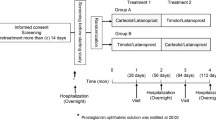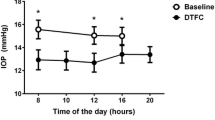Abstract
We performed a prospective, randomized double blind study comparing the cardiovascular and intraocular pressure (IOP) effects of unilateral therapy with clonidine 0.125% and apraclonidine hydrochloride 1.0% in 15 normal and 15 ocular hypertensive volunteers. Baseline values were obtained prior to instillation. One drop of test medication (clonidine, apraclonidine or placebo) was instilled unilaterally, and the postinstillation measurements were taken at 1, 2, 4, 6 and 8 hours. Apraclonidine 1% produced a maximum 31.4%±6.9% (4.83±1.17mmHg) decrease in mean IOP in ocular normotensive volunteers and 33.9%±6.9% (10.10±2.45 mmHg) in ocular hypertensive patients (p<0.001).
These values were 22.1%±6.9% (2.90±1.94 mmHg) and 22.7%±6.9 (6.80±2.31 mmHg), respectively in clonidine group (p<0.001).
In apraclonidine group, there were no changes in contralateral IOP, blood pressure or pulse rate. Clonidine produced a significant decrease in contralateral IOP, but this reduction was not statistically significantly different than that of placebo. In clonidine group, there was no change in pulse rate, but a significant decrease in blood pressure.
Eyelid retraction, conjunctival blanching and mydriasis were noted in eyes treated with apraclonidine. However there were no statistically and clinically significant changes in pupil size or interpalpebral fissure width with clonidine.
This study suggests that apraclonidine appears to be safer and more effective ocular hypotensive agent than clonidine in treatment of glaucoma.
Similar content being viewed by others
References
Shields MB. Textbook of glaucoma, 3rd ed. Baltimore: Williams & Wilkins, 1992: 468–71.
Harrison R, Kaufmann CS. Clonidine. Effects of topically administered solution on intraocular pressure and blood pressure in open-angle glaucoma. Arch Ophthalmol 1977; 95: 1369–73.
Hadopp E, Kolker AE, Kass MA, Goldberg I, Becker B, Gordon M. The effect of topical clonidine on intraocular pressure. Arch Ophthalmol 1981; 99: 1209–11.
Krieglstein GK, Langham ME, Leydhecker W. The peripheral and central neural actions of clonidine in normal and glaucomatous eyes. Invest Ophthalmol Vis Sci 1978; 17: 149–58.
Lee DA, Topper JE, Brubaker RF. Effect of Clonidine on Aqueous Humor Flow in normal human eyes. Exp Eye Res 1984; 38: 239–46.
Coleman AL, Robin AL, Pollack IP. Apraclonidine Hydrochloride. Ophthalmology Clinics of North America 1989; 2: 97–107.
Cavero I, Depoortere H, Lefevre-Borg F. Pharmacological studies on para-aminoclonidine. Br J Pharmacol 1980; 69: 295–6.
Brown RH, Stewart RH, Lynch MG, Crandall AS, Mandell AI, Wilensky JT, Schwartz AL, Gaasterland DE, deFaller JM, Higginbotham EJ. ALO 2145 reduces the intraocular pressure elevation after anterior segment laser surgery. Ophthalmology 1988; 95: 378–84.
Robin AL. Short-term effects of unilateral 1% apraclonidine therapy. Arch Ophthalmol 1988; 106: 912–5.
Abrams DA, Robin AL, Crandall AS, Caldwell DR, Schnitzer DB, Pollack IP, Rader JE, Reaves TA. A limited comparison of apraclonidine's dose response in subjects with normal or increased intraocular pressure. Am J Ophthalmol 1989; 108: 230–7.
Jampel HD, Robin AL, Quigley HA, Pollack IP. Apraclonidine. A one-week dose-response study. Arch Ophthalmol 1988; 106:1069–73.
Abrams DA, Robin AL, Pollack IP, deFaller JM, DeSantis L. The safety and efficacy of topical 1% ALO 2145 (paminoclonidine hydrochloride) in normal volunteers. Arch Ophthalmol 1987; 105: 1205–7.
Gharagozloo NZ, Relf SJ, Brubaker RF. Aqueous flow is reduced by the alpha-adrenergic agonist, apraclonidine hydrochloride (ALO 2145). Ophthalmology 1988; 95: 1217–20.
Chandler ML, DeSantis L. Studies of p-amino clonidine as a potential antiglaucoma agent. Invest Ophthalmol Vis Sci 1985; 25 (suppl): 227.
Kitazawa Y, Sugiyama K, Taniuchi T. The prevention of an acute rise in intraocular pressure following Q-switched Nd: YAG laser iridotomy with clonidine. Graefe Arch Clin Exp Ophthalmol 1989; 227: 13–6.
Potter DE, Crosson CE, Heath AR, Ogidigben MJ. Functional evidence for heterogeneity of ocular alpha-2 adrenoceptors. Proc West Pharmacol Soc 1990; 33: 257–60.
Kobilka BK, Matsui H, Kobilka TS, Yang-Feng TL, Francke U, Caron MG, Lefkowitz RJ, Regan JW. Cloning, sequencing, and expression of the gene coding for the human platelet alpha-2 adrenergic receptor. Science 1987; 238: 650–6.
Chien DS, Homsy JJ, Gluchowski C, Tang-Liu DDS. Corneal and conjunctival/scleral penetration of p-aminoclonidine, AGN 190342, and clonidine in rabbit eyes. Curr Eye Res 1990; 9: 1051–9.
Vocci MJ, Robin AL, Wahl JC, Mayer P, Graves A, York B, Enger C, Sutton J. Reformulation and drop size of apraclonidine hydrochloride. Am J Ophthalmol 1992; 113: 154–60.
Author information
Authors and Affiliations
Rights and permissions
About this article
Cite this article
Yüksel, N., Güler, C., Çaglar, Y. et al. Apraclonidine and clonidine: a comparison of efficacy and side effects in normal and ocular hypertensive volunteers. Int Ophthalmol 16, 337–342 (1992). https://doi.org/10.1007/BF00917987
Issue Date:
DOI: https://doi.org/10.1007/BF00917987




